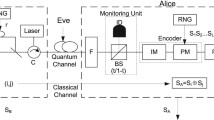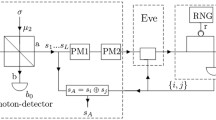Abstract
Round-robin differential-phase-shift (RRDPS) quantum key distribution (QKD) scheme provides an effective way to overcome the signal disturbance from the transmission process. However, most RRDPS-QKD schemes use weak coherent pulses (WCPs) as the replacement of the perfect single-photon source. Considering the heralded pair-coherent source (HPCS) can efficiently remove the shortcomings of WCPs, we propose a RRDPS-QKD scheme with HPCS in this paper. Both infinite-intensity decoy-state method and practical three-intensity decoy-state method are adopted to discuss the tight bound of the key rate of the proposed scheme. The results show that HPCS is a better candidate for the replacement of the perfect single-photon source, and both the key rate and the transmission distance are greatly increased in comparison with those results with WCPs when the length of the pulse trains is small. Simultaneously, the performance of the proposed scheme using three-intensity decoy states is close to that result using infinite-intensity decoy states when the length of pulse trains is small.





Similar content being viewed by others
References
Lo, H.K., Chau, H.F.: Unconditional security of quantum key distribution over arbitrarily long distances. Science 283, 2050 (1999)
Shor, P.W., Preskill, J.: Simple proof of security of the BB84 quantum key distribution protocol. Phys. Rev. Lett. 85, 441 (2000)
Bennett, C.H., Brassard, G.: Quantum cryptography. In: Proceedings of the IEEE International Conference Computers. Systems and Signal Processing, pp. 175–179. IEEE, New York (1984)
Ma, X.F., Qi, B., Zhao, Y., Lo, H.K.: Practical decoy state for quantum key distribution. Phys. Rev. A 72, 012326 (2005)
Wang, X.B.: Three-intensity decoy-state method for device-independent quantum key distribution with basis-dependent errors. Phys. Rev. A 87, 012320 (2013)
Zhao, S.M., Gong, L.Y., Li, Y.Q., Yang, H., Sheng, Y.B., Cheng, W.W.: A large-alphabet quantum key distribution protocol using orbital angular momentum entanglement. Chin. Phys. Lett. 30(6), 060305 (2013)
Wang, L., Zhao, S.M., Gong, L.Y., Cheng, W.W.: Free-space measurement-device-independent quantum-key-distribution protocol using decoy states with orbital angular momentum. Chin. Phys. B 24(12), 120307 (2015)
Chen, D., Zhao, S.H., Sun, Y.: Measurement-device-independent quantum key distribution with q-plate. Quantum Inf. Process. 14(12), 4575–4584 (2015)
Leverrier, A., Grangier, P.: Unconditional security proof of long-distance continuous-variable quantum key distribution with discrete modulation. Phys. Rev. Lett. 102, 180504 (2009)
Jouguet, P., Kunz-Jacques, S., Leverrier, A., Grangier, P., Diamanti, E.: Experimental demonstration of long-distance continuous-variable quantum key distribution. Nat. Photonics 7, 378–381 (2013)
Guo, Y., Lv, G., Zeng, G.: Balancing continuous-variable quantum key distribution with source-tunable linear optics cloning machine. Quantum Inf. Process. 14(11), 4323–4338 (2015)
Sasaki, T., Yamamoto, Y., Koashi, M.: Practical quantum key distribution protocol without monitoring signal disturbance. Nature 509, 475 (2014)
Mizutani, A., Imoto, N., Tamaki, K.: Robustness of the round-robin differential-phase-shift quantum-key-distribution protocol against source flaws. Phys. Rev. A 92, 060303 (2015)
Zhang, Z., Yuan, X., Cao, Z., Ma, X.: Round-robin differential-phase-shift quantum key distribution. arXiv:1505.02481 (2015)
Zhang, Y.Y., Bao, W.S., Zhou, C., Li, H.W., Wang, Y., Jiang, M.S.: Practical decoy-state round-robin differential-phase shift quantum key distribution. arXiv:1605.02853 (2016)
Cao, Z., Yin, Z.Q., Han, Z.F.: Trustworthiness of measurement devices in round-robin differential-phase-shift quantum key distribution. Phys. Rev. A 93, 022310 (2016)
Yin, H.L., Fu, Y., Mao, Y., Chen, Z.B.: Detector-decoy quantum key distribution without monitoring signal disturbance. Phys. Rev. A 93, 022330 (2016)
Guan, J.Y., Cao, Z., Liu, Y., Shen-Tu, G.L., Pelc, J.S., Fejer, M.M., Peng, C.Z., Ma, X., Zhang, Q., Pan, J.W.: Experimental passive round-robin differential phase-shift quantum key distribution. Phys. Rev. Lett. 114, 180502 (2015)
Takesue, H., Sasaki, T., Tamaki, K., Koashi, M.: Experimental quantum key distribution without monitoring signal disturbance. Nat. Photonics 9, 827–831 (2015)
Li, Y.H., Cao, Y., Dai, H., Lin, J., Zhang, Z., Chen, W., Xu, Y., Guan, J.Y., Liao, S.K., Yin, J., Zhang, Q., Ma, X., Peng, C.Z., Pan, J.W.: Experimental round-robin differential phase-shift quantum key distribution. Phys. Rev. A 93, 030302(R) (2016)
Wang, S., Yin, Z.Q., Chen, W., He, D.Y., Song, X.T., Li, H.W., Zhang, L.J., Zhou, Z., Guo, G.C., Han, Z.F.: Experimental demonstration of a quantum key distribution without signal disturbance monitoring. Nat. Photonics 9, 832 (2015)
Agarwal, G.S.: Generation of pair coherent states and squeezing via the competition of four-wave mixing and amplified spontaneous emission. Phys. Rev. Lett. 57, 827 (1986)
Usenko, V.C., Paris, M.G.A.: Multiphoton communication in lossy channels with photon-number entangled states. Phys. Rev. A 75, 043812 (2007)
Zhang, S.L., Zou, X.B., Li, C.F., Jin, C.H., Guo, G.C.: A universal coherent source quantum key distribution. Chin. Sci. Bull. 54, 1863–1871 (2009)
Zhu, F., Zhang, C.H., Liu, A.P., Wang, Q.: Enhancing the performance of the measurement-device-independent quantum key distribution with heralded pair-coherent sources. Phys. Lett. A 380, 1408–1413 (2016)
U’Ren, A.B., Silberhorn, C., Banaszek, K., Walmsley, I.A.: Efficient conditional preparation of high-fidelity single photon states for fiber-optic quantum networks. Phys. Rev. Lett. 93, 093601 (2004)
Horikiri, T., Kobayashi, T.: Decoy state quantum key distribution with a photon number resolved heralded single photon source. Phys. Rev. A 73, 032331 (2006)
Dong, Y.L., Zou, X.B., Guo, G.C.: Generation of pair coherent state using weak cross-Kerr media. Phys. Lett. A 372, 5677–5680 (2008)
Acknowledgements
The paper is supported in part by the National Natural Science Foundation of China (61271238 and 61475075) and the open research fund of Key Lab of Broadband Wireless Communication and Sensor Network Technology, Ministry of Education (NYKL2015011).
Author information
Authors and Affiliations
Corresponding author
Appendix
Appendix
1.1 The lower bound of the yield
First, Alice and Bob can estimate the lower bound of the background yield, \(Y_{0}^{L}\), by
where the inequality is due to \(L^2\nu _1^2\nu _2^2 \sum _{n=2}^{\infty }\Big (\frac{(L\nu _1)^{2n-2}-(L\nu _2)^{2n-2}}{(n!)^2} [1-(1-d_\mathrm{A})(1-\eta _\mathrm{A})^n]Y_n\Big )\ge 0\). Thus, the lower bound of \(Y_{0}\) is given by
where the equality sign will hold when \(\nu _{2}=0\). By \(P_\mathrm{post}(L\nu _{1})Q_{L\nu _{1}}-P_\mathrm{post}(L\nu _{2})Q_{L\nu _{2}}\), Alice and Bob have
Here, the inequality that \(a^{i}-b^{i}\le a^{2}-b^{2}\) when \(a\ge b\ge 0\), \(a+b\le 1\) and \(i\ge 2\) is used to prove the first inequality in Eq. 24. The second inequality in Eq. 24 is due to Eq. 23. Then, they can obtain the lower bound of the single-photon pulse trains yield \(Y_{1}\),
Furthermore, Alice and Bob can estimate the lower bound of the two-photon pulse trains yield, \(Y_{2}^{L}\), by
Here, the inequality that \(a^{i}-b^{i}\le a^{3}-b^{3}\) when \(a\ge b\ge 0\), \(a+b\le 1\) and \(i\ge 3\) is used to prove the first inequality in Eq. 26. The second inequality in Eq. 26 is due to Eqs. 25 and 23. The lower bound of \(Y_{2}\) is
1.2 The upper bound of the error rate
Alice and Bob can estimate the upper bound of the error rate, \(e_{1}^{U}\) and \(e_{2}^{U}\). According to the following inequality,
where the inequality is due to \(\sum _{n=2}^{\infty }\left( \frac{(L\nu _1)^{2n}-(L\nu _2)^{2n}}{(n!)^2} [1-(1-d_\mathrm{A})(1-\eta _\mathrm{A})^n]e_{n}Y_n\right) \ge 0\), the upper bound of \(e_{1}\) is given by
Then, Alice and Bob can estimate the upper bound of the two-photon pulse trains error rate, \(e_{2}^{U}\), by
where the inequality is due to \(\sum _{n=3}^{\infty }\big (\frac{(\nu _2^2-\nu _3^2) [(L\nu _1)^{2n}-(L\nu _2)^{2n}] +(\nu _1^2-\nu _2^2)[(L\nu _3)^{2n}-(L\nu _2)^{2n}]}{(n!)^2} [1-(1-d_\mathrm{A})(1-\eta _\mathrm{A})^n]e_nY_n\big )\ge 0\), and the upper bound of \(e_{2}\) is given by
Rights and permissions
About this article
Cite this article
Wang, L., Zhao, S. Round-robin differential-phase-shift quantum key distribution with heralded pair-coherent sources. Quantum Inf Process 16, 100 (2017). https://doi.org/10.1007/s11128-017-1550-x
Received:
Accepted:
Published:
DOI: https://doi.org/10.1007/s11128-017-1550-x




